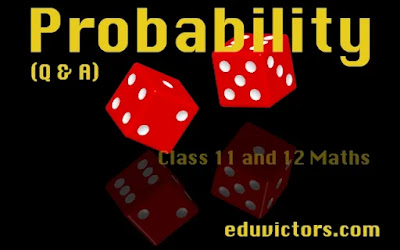Class 11 & 12 Maths - Probability - Part 1 (Solved Questions)
Let us revisit the basic terminology used in probability.
Q1: Define probability. What can the probability never predict?
Answer: Probability gives us a measure of the likelihood that something will happen. However, probability can never predict the number of times that an occurrence actually happens.
Q2: Define experiment.
Answer: An action or operation resulting in two or more well-defined outcomes.
e.g. tossing a coin, throwing a die, drawing a card from a pack of well-shuffled playing cards etc.
Q3: What is a sample space (S)?
Answer: Sample space is a set S that consists of all possible outcomes of a random experiment. Each outcome is called a sample point. Often, there will be more than one sample space that can describe the outcomes of an experiment, but there is usually only one that will provide the most information.
e.g. in an experiment of "throwing a die", the following sample spaces are possible:
⒜ {even number, odd number}
⒝ {a number less than 3, a number equal to 3, a number greater than 3}
⒞ {1,2,3,4,5,6}
In the above case, the third ⒞ Sample Space provides the most information.
Q4: What is an event?
Answer: Event: An event is defined as an occurrence or situation, for example
(i) in a toss of a coin, it shows head,
(ii) scoring a six on the throw of a die,
Event (A) is a subset of sample space (S)
👉Important Points To Note:
• An experiment is a process that produces an observation.
• An outcome is a possible observation.
• The set of all possible outcomes is called the sample space.
• An event is a subset of the sample space.
• A trial is a single running of an experiment.
Q5: What is a simple or elementary event?
Answer: An event consisting of a single point of S is called a simple or elementary event.
👉Important Points To Note:
• Probability of occurrence of an event A is denoted by P(A)
• ϕ is called impossible event (an event which is impossible to occur)
• S (sample space) is called a sure event i.e. it is 100% certain that it will occur.
Q6: What is a compound event?
Answer: Compound Event: If an event has more than one sample point it is called Compound Event. If A & B are two given events then A ⋂ B is called compound event and is denoted by A ⋂ B or AB or A & B.
Q7: What is meant by 'complement of an event?
Answer: The set of all outcomes which are in S but not in A is called the complement of the event A. It is denoted as A' or $\overline{A}$
Q8: When two events are said to be mutually exclusive?
Answer: Two events are said to be Mutually Exclusive (or disjoint or incompatible) if the occurrence of one precludes (rules out) the simultaneous occurrence of the other. If A & B are two mutually exclusive events then P (A⋂B) = 0.
Q9: What are equally likely events?
Answer: Two events A & B are said to be equally likely if P(A) = P(B)
Q10: What is the Additive theorem?
Answer: For any two events A and B:
P(A⋃B) = P(A) + P(B) - P(A⋂B)
Q11: A number is selected at random from first 200 numbers. What is the chance that it is divisble by either 4 or 6?
Answer: Here S = {1, 2, 3,..., 200}
Event A: divisble by 4, favourable outcomes = 50 i.e. {4, 8, 12,... 200}
Event B: divisble by 6, favourable outcomes = 33 i.e. {6, 12, 18, ..., 198}
LCM of 4 and 6 = 12
P(A⋂B) = $\frac{200}{16}$
P(A⋃B) = P(A) + P(B) - P(A⋂B)
= $\frac{50}{200} + \frac{33}{200} - \frac{200}{16}$
= $\frac{67}{200}$
For class XI, we'll solve problems related to Sample Spaces in the next post.
For Class XII, we'll solve problems related to Conditional Probability.
👉See Also:
Class 12 Maths:
Maths Sample Question Paper with Marking Scheme (2016)
Special Mathematical ConstantsTypes of VectorsIntroduction to Matrices (Part-1) Q & A
Maths Sample Question Paper + Marking Scheme (2018-19)
Maths Sample Question Paper + Marking Scheme (2020-21)
Maths Preboard Sample Question Paper Set2 (2020-21)
Class 11 Maths:
Ch2: Relations and Functions (1 Mark Q & A) Part-1
Ch2: Cartesian Product of Two Sets (Important Points)
Ch2: Relations - Domain, Range and Co-Domain (Solved Problems)
Ch5: Complex Numbers (Part 1) - Solved Problems
Ch 13 Limits and Derivatives (Q & A ) Part -1
Ch 13 Limits and Derivatives (Q & A) Part - 2
Ch 13 Limits and Derivatives (Q & A) Part - 3
Ch 13 Limits and Derivatives (Q & A) Part- 4
Ch 13 Limits and Derivatives (Q & A) Part- 5
Maths Annual Test Paper (2018-19)
Maths Annual Test Paper (2020-21)
Linear Programming (LPP) - Key Points

No comments:
Post a Comment
We love to hear your thoughts about this post!
Note: only a member of this blog may post a comment.